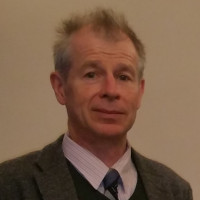
Ramsden's book 'Nanotechnology: An Introduction', courtesy Elsevier
In response to our article about Professor Silvia Vignolini’s research group in the Spring 2022 edition of Chem@Cam Jeremy Ramsden writes:
“Reading about sustainable decorative glitter derived from cellulose raises the question whether we need glitter at all. Similar considerations apply to fireworks and a host of other superfluities — they are not essential for our survival. The question is where to draw the line — I do not know the answer. But it seems incontrovertible that if we are to maintain the
present large human population, in order to achieve sustainability we shall all have to accept a great deal more material austerity than hitherto. It will be hard enough to make what is essential truly sustainable.”
Jeremy Ramsden (Fitzwilliam 1974)
Career
For most of his long and varied career, Jeremy Ramsden has studied particles much smaller than glitter—in fact, he is an expert in nanotechnology.
After completing his undergraduate degree here in Chemistry, Jeremy spent three years as a research scientist at Ilford Limited, founded in 1879 as one of the original pioneers in the photo industry. Inspired by his research into the photolysis of silver halide nanoparticles, Jeremy went on to complete a PhD in semiconductor nanoparticles at the Swiss Federal Institute of Technology in Lausanne (EPFL).
Two postdocs followed: First at Princeton, where he worked on infrared and Raman spectroscopy to elucidate the structure and dynamics of haem proteins, and on cellular automata for protein folding; and then at the Biological Research Centre of the Hungarian Academy of Sciences in Szeged, where his interest in nanomaterials broadened to the interface between inorganic (semiconductors) and biological materials.
University of Basel and nanometrology
 In 1988, Jeremy became a researcher at the Biozentrum of the University of Basel, which specialises in research into the molecular organisation of living organisms.
In 1988, Jeremy became a researcher at the Biozentrum of the University of Basel, which specialises in research into the molecular organisation of living organisms.
While in Basel, Jeremy became interested in nanometrology, using sensitive optical waveguide-based techniques to elucidate the structure and dynamics of the bio/nano interface. He also studied the kinetics of adsorption and desorption processes – especially proteins and the solid/liquid interface.
Swiss neutrality gave Jeremy the opportunity to conduct research at the A.N. Frumkin Institute of Electrochemistry at the USSR Academy of Sciences in Moscow, which he recalls as ‘a hotbed of leading scientists’, where he further developed his ideas about the bio/nano interface.
Jeremy Ramsden
In 1994 Jeremy joined the University of Basel faculty after gaining the required ‘habilitation,’ a qualification necessary to become a Professor in Switzerland.
It was also during this time that Jeremy first became fascinated by the complexity of biological processes and the role of information in the living world. “Just like in the sense of telecommunications that transmit along a channel, the nervous system is always transmitting information,” explains Jeremy. “Organisms have signal transduction pathways, and the capacity of these channels is of fundamental importance in the living world.”
Interest in Bioinformatics
During a stint as a visiting professor in France, Jeremy became further aware that the signalling in plants, using chemical pathways, is as sophisticated as that in animals. This interest eventually led to Jeremy’s book: Bioinformatics: An Introduction, first published in 2004 and now in its third edition.
Jeremy remained in Basel until 2002, when he was appointed as Professor and Chair of Nanotechnology at Cranfield University -- the UK's only postgraduate university.
At the same time, Jeremy served as Research Director for Bio-nanotechnology at Cranfield's campus at Kitakyushu, Japan. “I used to go to Japan three or four times a year, and stay a few weeks each time,” he recalls. In addition to furthering his research, it was also where Jeremy met his future wife, with whom he now has 13-year-old twins.
Focus on start-ups
Nowadays Jeremy focuses on start-ups in nanomaterials and nanodevices. He is a co-founder of VN Aerotoxic Detection Solutions Limited, which is developing a fibre-optic sensor Jeremy invented while at Cranfield. The ‘Canary’ nano optical sensor will be used for real-time detection of poisonous compounds in aircraft cabin air. “We are still in the research and development phase, but we’ve been successful in raising the money we need for development and hope to have our first product ready for launch at the end of the year,” he says.
This work has led to a new company called Virusense, which is developing the same technology to measure the presence of the SARS-CoV-2 virus in local atmospheres and for screening patients.
In addition to writing several more books, Jeremy has authored or co-authored over 300 research papers, and enjoyed stints as visiting professor in diverse places including Argentina, France, Georgia, Hungary and Japan. He continues as honorary Professor at the University of Buckingham.
Your comments welcome
Where do you stand on the issue of glitter? Is even sustainable glitter an unnecessary frivolity or do we humans need a glitter-fest every now and again?
Jeremy says: “When I said I don’t know the answer, I really don’t. I haven’t come to a decisive view on that question. When I see confetti being used at weddings I think why don’t they use rose petals? I’ve come to think that a lot of these things are superfluous but if something were biodegradable I’d prefer that."
******
We welcome your thoughts on this and any other science-related topic: please write to the editor of Chem@Cam at news@ch.cam.ac.uk.
